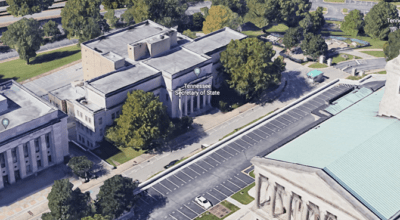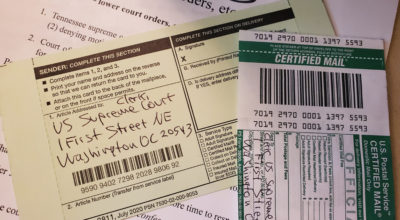

CHATTANOOGA, Tenn., Feb. 12, 2023 – The city is creating 86 “smart intersections” downtown through 2024 for what one report calls the “largest Internet of things network of its kind” that will “pave the way for electric vehicles.”
By David Tulis / NoogaRadio Network
The network is described as a “living laboratory” equipped with light detection and ranging sensors “leveraging 3D-perception software” to detect, track and predict vehicle and pedestrian movements “without invading privacy.”
Mayor Tim Kelly names Tuesday nine board members of the city’s bus cartel, CARTA, several of whom have strong credentials for laying “the groundwork for an expanded, next-generation public transit system” with “affordable mobility options that open up opportunity for every neighborhood.”
The Chattanooga Department of Innovation Delivery and Performance partnered with the Center of Urban Informatics and Progress at UTC in 2019 to create the MLK Smart Corridor. CUIP will mine the data for “mobility mapping and tracking insights.”
“The level of accuracy and actionability has enabled numerous advancements in how we can make our city safer, more efficient and healthier for the people who live here,” says Mina Sartipi, founding director of the smart city and urbanization research center. “By expanding the project footprint, we will not only position Chattanooga as a pioneer of smart city technology but also create a blueprint for other cities around the United States to leverage the transformative capabilities of 3D systems.”
A F$4.6 million grant from the federal highway administration is paying for the project. The gloss on the project is that it will help “to plan electric vehicle charging stations in busy locations and monitor their subsequent use.”
According to Smart Tech magazine online, “The 3D-perception software further relies on machine learning with weather-filtering capabilities to analyze granular, real-time data and predict accidents and wrong-way driving, as well as to understand traffic flow and interactions. In this way, CUIP and Chattanooga hope to optimize routes to alleviate traffic congestion and reduce emissions.”
Chattanooga is a World Economic Forum-favored city with an elite that has worked since the 1980s to refashion public opinion and elite commitments in favor of public-private forms of a polity called “governance.” The inclusivity promoted by global elites is premised on the entirety of the population being on the Internet and ultimately measurable one by one, and thus manageable in a digital Gulag.
Says the WEF, “The benefits of digitally enriched infrastructure in cities can be difficult to obtain, yet its importance is broadly recognized by the public, government, business and the non-profit sector in addressing a range of social and environmental issues.”
Hamilton County schools are gung-ho for the smart city concept. “What we’re committed to is closing gaps, to ensuring that we’re creating opportunities for each and every student,” says Supt. Justin Robertson in a Times Free Press story. “When we’re talking about ‘every,’ it’s each and every. Each and every student. Each and every family. Each and every community right here in East Brainerd to the furthest tip in north Hamilton County.”
The county retires its Future 2023 plan for schools to replace it with the more stylish NOW moniker, Opportunity 2030, in service of the tech and global smart city agenda.
Globalism and entering alliances with foreign money interests requires layer after layer of programs, schemes and plans. One is the “Safe Streets and Roads for All” program that requires creating roadway safety plan. “The grant will go towards developing a comprehensive safety action plan that will help us improve pedestrian, cyclists, and drivers’ safety on our road network,“ says mayor official Kirsten Yates. A TV report Feb. 1 says that the plan “will be centered on a platform that integrates data from different streams” such as 911 calls, CPD crash data. “We’ll be able to use that data to then identify high risk intersections and roadways and then prioritize some potential behavioral and engineering solutions that will help ultimately make our roadways safer,“ says Yates. It’s not immediately clear if this program is distinct from the MLK Corridor project.

‘Top city in the U.S.’
“Chattanooga is, by some measures, the top city in the United States in terms of broadband access and speed, and is on the forefront of all kinds of innovation, including around the development of the smart city concept.” Lena Geraghty, director of sustainability and innovation with the National League of Cities, and Dr. Mina Sartipi, the founding director of the Center for Urban Informatics and Progress at UTC, say broadband access is the key for a smart city.
“The foundation of a smart city solution is having broadband internet be ubiquitous throughout the community,” says Geraghty.
Intersection sensors are pitched as enabling a seamless web of convenience and connectivity.
Imagine what we can accomplish if we can more accurately perceive our world beyond what’s visible to the human eye: roadways will be safer for both drivers and pedestrians, stores are optimized based on the customer journey, and airports experience reduced wait times. Those are just the immediate benefits that come from installing 3D systems. With SENSR 3.0, never before has it been so simple to set up, calibrate, and scale a 3D system, and this will revolutionize how companies gain value from our technology.
— William Muller, Seoul Robotics vice president of Business Development
Dr. Sartipi says the system gives “new dimension of insights beyond what we anticipated. The level of accuracy and actionability has enabled numerous advancements in how we can make our city safer, more efficient, and healthier.” (“Building the foundation for smart city development is complex, but the payoff is worth it[;] For maximum and sustained success, a strong private/public partnership must be at the core,” Geoweek News, Jan 19, 2023)
The digital infrastructure is required to build a digital duplicate of Chattanooga. A twin city, in other words. Oak Ridge National Laboratory and UTC are working together (military and academic institutions unite).
Kevin Comstock, consultant with KCI Technologies and former Smart City director for Chattanooga, is helping build the digital twin. The system uses satellite and sensor data.
The exhaustive totalistic nature of the surveillance is visible between the lines in this quote in a CNN story about smart cities and its traffic safety premise.
“Another ongoing project uses sensors and laser imaging at intersections to monitor pedestrian movements and compare it to vehicle traffic, in the interest of safety [emphasis added]. ‘If we know where pedestrians are in the intersection, and we know where cars are in the intersection, we can begin to mimic “near-miss” activity,’ Comstock says, by tracking pedestrians and bicyclists who alter their course to avoid cars.”
The story says that near misses, sadly, aren’t recorded. “Collecting data on them would provide more accurate information on how safe an intersection is, says Comstock, enabling him to figure out how to resolve issues.”
Says CNN, “Using real-time data and artificial intelligence, digital twins become virtual, living mirrors of their physical counterparts – providing opportunities to simulate everything from infrastructure and construction to traffic patterns and energy consumption.” (Samantha Bresnahan, “Cities are being cloned in the virtual world. Here’s what that means for the future,” CNN, Jan. 31, 2023)
The city closed a data center in 2016 and moved its digital systems to the cloud, the Wall Street Journal says, relying on Google Cloud and Amazon Web Services.
The business-boosting group Co.lab is orienting itself toward Gig City goals and moving from the Edney Building downtown to the North Shore. It plans to join in the integration process in the “smart city” plan. Notes the Times Free Press:
CO.LAB is still active with programs such as KIVA, CO.STARTERS and rural outreach But as CO.LAB moves from the Edney building to the newest Society of Work complex at the Somerville location on Cherokee Boulevard, Malakasis said she is working to raise capital and attention to the potentially revolutionizing industry of sustainable mobility and the ways that new businesses can test out their concepts in Chattanooga.
“We are open to exploring potential partnerships and opportunities to collaborate together,” [new CEO Tasia] Malakasis said. “With the city’s strength of industry backed by cutting-edge research teams dedicated to exploring clean, sustainable energy sources, Quantum networking, freight technology, Smart Traffic solutions, and electric + autonomous vehicles, Chattanooga now has testbeds in these areas that exist nowhere else on the planet.” (Dave Flessner, “Chattanooga’s Company Lab launches sustainable mobility program for startups,” Times Free Press, Feb. 4, 2023)
Romanello reveals ‘smart city’ goals


It is more than an irony that the focus is MLK Boulevard. If I recall correctly he spoke a bit on the issue of what is known as African-Americans.
To power those electric vehicles a whole lot of cobalt and lithium is mined in Africa by a lot of people who don’t get paid, mostly kids. There is a word for that isn’t there? But that doesn’t matter since these are not African-Americans, but African-Africans. Do I have that right? Or is there an issue of being a human being created in the image of God?
Then we need to “monitor their subsequent use.” Perhaps we should use the tag line “know everything about everyone.” Maybe not since that was used by the East German Stasi. Maybe we should use the NSA’s line of “collect it all, exploit it all.” After all, we can trust our government, right? The proper response is to say “Hail Victory.”
Satire aside, this is program is disgusting and dangerous!